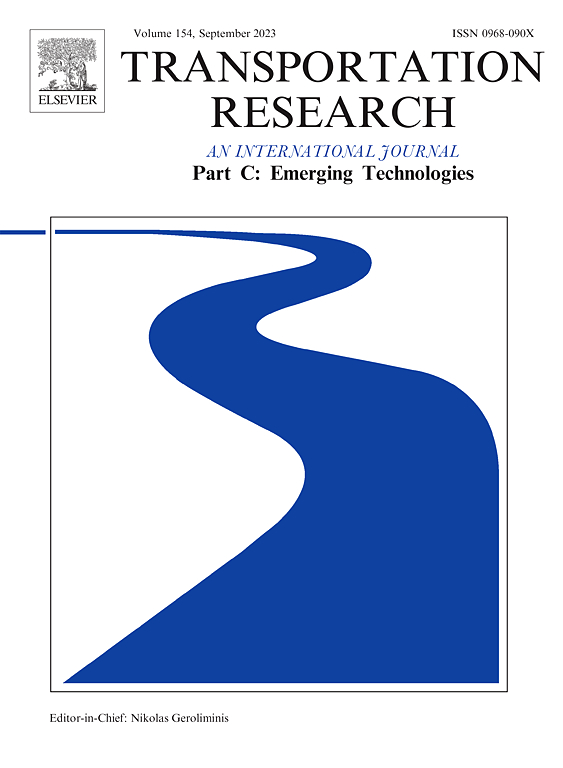Online adaptive platoon control for connected and automated vehicles via physics enhanced residual learning
IF 7.6
1区 工程技术
Q1 TRANSPORTATION SCIENCE & TECHNOLOGY
Transportation Research Part C-Emerging Technologies
Pub Date : 2025-06-18
DOI:10.1016/j.trc.2025.105242
引用次数: 0
Abstract
This paper introduces a physics enhanced residual learning (PERL) framework for connected and automated vehicle (CAV) platoon control, addressing the dynamics and unpredictability inherent to platoon systems. The framework first develops a physics-based controller to model vehicle dynamics, using driving speed as input to optimize safety and efficiency. Then the residual controller, based on neural network (NN) learning, enriches the prior knowledge of the physical model and corrects residuals caused by vehicle dynamics. By integrating the physical model with data-driven online learning, the PERL framework retains the interpretability and transparency of physics-based models and enhances the adaptability and precision of data-driven learning, achieving significant improvements in computational efficiency and control accuracy in dynamic scenarios. Simulation and robot car platform tests demonstrate that PERL significantly outperforms pure physical and learning models, reducing average cumulative absolute position and speed errors by up to 58.5% and 40.1% (physical model) and 58.4% and 47.7% (NN model). The reduced-scale robot car platform tests further validate the adaptive PERL framework’s superior accuracy and rapid convergence under dynamic disturbances, reducing position and speed cumulative errors by 72.73% and 99.05% (physical model) and 64.71% and 72.58% (NN model). PERL enhances platoon control performance through online parameter updates when external disturbances are detected. Results demonstrate the advanced framework’s exceptional accuracy and rapid convergence capabilities, proving its effectiveness in maintaining platoon stability under diverse conditions.
基于物理增强残差学习的网联自动车辆在线自适应排控制
本文介绍了一个物理增强残差学习(PERL)框架,用于连接和自动车辆(CAV)队列控制,解决队列系统固有的动态性和不可预测性。该框架首先开发了一个基于物理的控制器来模拟车辆动力学,使用驾驶速度作为输入来优化安全性和效率。残差控制器基于神经网络学习,丰富了物理模型的先验知识,并对车辆动力学引起的残差进行了校正。通过将物理模型与数据驱动在线学习相结合,PERL框架保留了基于物理模型的可解释性和透明性,增强了数据驱动学习的适应性和精度,显著提高了动态场景下的计算效率和控制精度。仿真和机器人汽车平台测试表明,PERL显著优于纯物理模型和学习模型,将平均累积绝对位置和速度误差分别降低58.5%和40.1%(物理模型)和58.4%和47.7% (NN模型)。缩小比例的机器人汽车平台测试进一步验证了自适应PERL框架在动态扰动下的优越精度和快速收敛性,物理模型下的位置和速度累积误差分别降低了72.73%和99.05%,神经网络模型下的位置和速度累积误差分别降低了64.71%和72.58%。当检测到外部干扰时,PERL通过在线参数更新来增强排控制性能。结果表明,先进的框架具有卓越的精度和快速收敛能力,证明了其在各种条件下保持排稳定性的有效性。
本文章由计算机程序翻译,如有差异,请以英文原文为准。
求助全文
约1分钟内获得全文
求助全文
来源期刊
CiteScore
15.80
自引率
12.00%
发文量
332
审稿时长
64 days
期刊介绍:
Transportation Research: Part C (TR_C) is dedicated to showcasing high-quality, scholarly research that delves into the development, applications, and implications of transportation systems and emerging technologies. Our focus lies not solely on individual technologies, but rather on their broader implications for the planning, design, operation, control, maintenance, and rehabilitation of transportation systems, services, and components. In essence, the intellectual core of the journal revolves around the transportation aspect rather than the technology itself. We actively encourage the integration of quantitative methods from diverse fields such as operations research, control systems, complex networks, computer science, and artificial intelligence. Join us in exploring the intersection of transportation systems and emerging technologies to drive innovation and progress in the field.

 求助内容:
求助内容: 应助结果提醒方式:
应助结果提醒方式:


